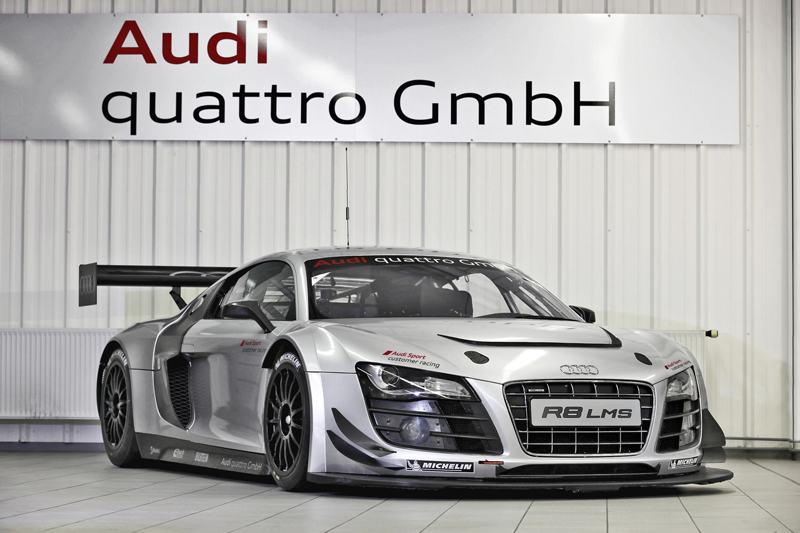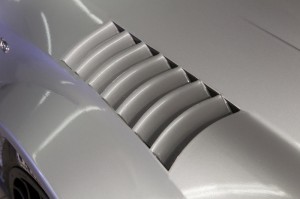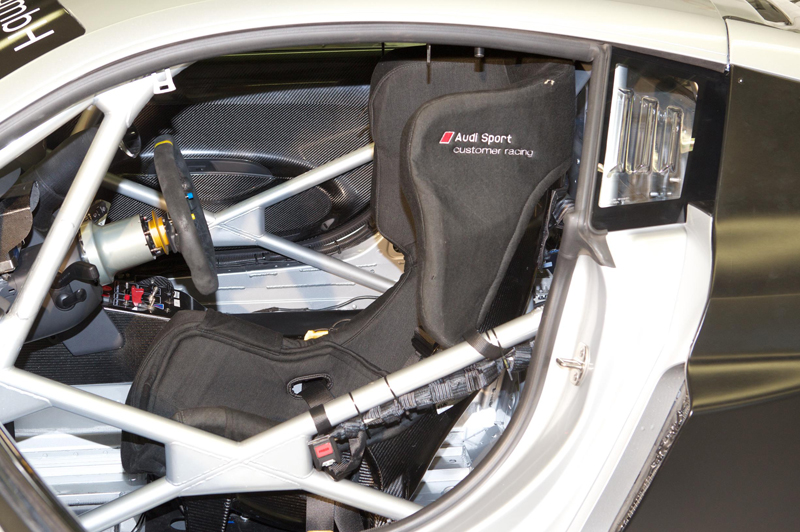Romolo Liebchen, Head of Customer Sport at quattro GmbH, and his development team focused on several central areas.
 New doors made of CFRP (carbon fibre reinforced plastic) in combination with high-energy absorbing new crash foams not only help reduce the race car’s weight even further but also result in another increase in passive safety. The new PS1 safety seat developed by Audi, which is now part of the standard equipment, serves this purpose as well. It offers perfect protection and clearly surpasses the mandatory minimum requirements under extreme loads.
New doors made of CFRP (carbon fibre reinforced plastic) in combination with high-energy absorbing new crash foams not only help reduce the race car’s weight even further but also result in another increase in passive safety. The new PS1 safety seat developed by Audi, which is now part of the standard equipment, serves this purpose as well. It offers perfect protection and clearly surpasses the mandatory minimum requirements under extreme loads.
An updated transmission provides additional reserves on long-distance runs. In the past season, the Audi R8 LMS had already made its mark as an excellent long-distance expert and achieved overall victories at the Bathurst (Australia) 12 Hours, the Spa and Zolder 24 Hours and GT3 class victory plus third place overall at the Nürburgring 24 Hours.
A new exhaust system equipped with race catalytic converters helps improve the engine’s characteristics. The V10 mid-engine can draw on even higher torque at lower engine speeds. The 5.2-litre unit delivers a power output of up to 570 bhp, depending on restrictor regulations. It is still based on the production engine produced at Audi’s plant in Györ, Hungary. Mileages of up to 20,000 kilometres were certainly typical in customer operations before and continue to be easily achieved.
An optimised cooling system for the race car successfully combines several objectives. In addition to a larger engine oil cooler and transmission fluid cooler, an oil cooler for the steering hydraulics that used to be installed at the front is now located in the vehicle’s mid-section.
The characteristic side blades of the Audi R8 enable enlarged air vents for the cooling system in the new R8 LMS ultra for improved thermal management. At the same time, air supply to the radiator at the front of the vehicle has been improved, as has the interior ventilation.
The chassis of the Audi R8 LMS ultra was updated in several steps. At the front 12-inch, instead of 11-inch, wheels are now used. As of the next season, development partner Michelin will be offering wider – 30-65/18 – tyres, which allow more consistent lap times to be achieved. Optimised brake cooling at the front wheels improves the durability of the braking system.
Instead of the previous silent rubber mounts the transverse control arm mounts now feature uniball joints. Weight-reduced compression and rebound-adjustable gas dampers with optimised characteristics from partner Bilstein complete the chassis package and represent the latest state of development.
Aerodynamic improvements complement the changes for 2012. The wider front hood has been optionally provided with louvres, subject to permission by the homologation rules for the various racing series. The new rear wing has been widened and now features larger end plates. Work in the Audi wind tunnel has led to a yet more efficient position of the wing for maximum downforce and minimised aerodynamic drag. The improved air flow and larger effective area increase downforce on the rear axle. A new front plate with optimised diffusion under the front end guarantees perfect aerodynamic balance.
As of 2012, all new vehicles will be equipped with the evolution stage (as described above). For the existing vehicles, quattro GmbH offers conversions to the 2012 evolution stage.
Deliveries will commence in March 2012.


